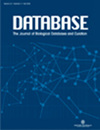投稿信息
稿件收录要求
Huge volumes of primary data are currently archived in numerous open-access databases, and with new generation technologies becoming more common in laboratories, large datasets will become even more prevalent than today. The lasting archiving, accurate curation, efficient analysis and precise interpretation of all of these data are a challenge. Collectively, database development and biocuration are at the forefront of the endeavor to make sense of this mounting deluge of data.
Database: The Journal of Biological Databases and Curation provides an open access platform for the presentation of novel ideas in database research surrounding biological information, and aims to help strengthen the bridge between database developers, curators, and users. In addition, the journal will provide a platform for the description of novel advances in the field of biocuration and promote the use of information from biological databases to assist in the planning and design of original research projects. Biocuration involves the translation of information relevant to biology and medicine, into an organized format, typically as a database, which enables the integration of scientific literature as well as large datasets such that information is accurately represented and readily accessible, as a source of information for scientists, and as a basis for computational analysis.
The journal will publish:
- Detailed descriptions of databases, and database tools, in the broad arena of biology - authors are strongly encouraged to include a biological discovery or a ''testable'' hypothesis in their papers.
- Shorter papers describing significant updates to established databases.
- Objective reviews of complementary and ancillary databases and database tools.
- User tutorials for database tools.
- Methodology and technical notes on database development.
- Improvements to automated prediction and annotation for biomedical datasets.
- Detailed descriptions of the state and updating of the annotation of genomes.
- Descriptions of the development and content of ontologies of relevance to the biomedical community and the tools specific to the use of these ontologies.
- Articles relevant to the annotation process such as standards for curation, annotation best practices, annotation methodologies, the use of automated and semi-automated methods for annotation and the measures for annotation consistency.
- Perspective manuscripts describing novel approaches, technologies, standards, or methods for database and/or annotation explorations including comparisons of state-of-the-art approaches. Perspectives can also include opinion pieces addressing challenges or debates in the field of biological databases and biocuration.
- Brief invited conference reports on topics related to the scope of the journal.
Descriptions of databases and biocuration application and activities in all areas of biology are welcome, including biological chemistry, genomics, proteomics, glycomics, molecular biology, biomedicine, physiology, ecology, botany, zoology, and taxonomy.




